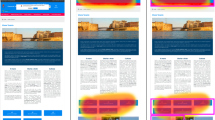Abstract
Research in ambient intelligent systems faces a challenging endeavor, namely the evaluation of user experience of ambient displays. Due to the fact that ambient displays should be unobtrusive, it is hard for users to appraise them on a reflective level (i.e. interviews and questionnaires). In this paper we present a methodological approach that combines an implicit (the Affect Misattribution Procedure (AMP)) and an explicit measurement technique (questionnaire for the persuasive effect (PeQ)) to tackle this problem. We used this approach in a study of an interface (Operator Guide) that provides information to operators in a semiconductor factory. Results show that the implicit technique is better suited to assess fine attitudinal differences on how users experience the display than explicit questionnaires. However, explicit measures are valuable to gain suggestions for improvements and thus it is concluded that this method triangulation adds value for the research on ambient persuasive interfaces.
Access this chapter
Tax calculation will be finalised at checkout
Purchases are for personal use only
Preview
Unable to display preview. Download preview PDF.
Similar content being viewed by others
References
Weiser, M.: The Computer for the 21st Century. Scientific American 265, 94–104 (1991)
Aarts, E.: Ambient Intelligence: A Multimedia Perspective. IEEE MultiMedia 11, 12–19 (2004)
Ishii, H., Ullmer, B.: Tangible bits: towards seamless interfaces between people, bits and atoms. In: Proceedings of CHI 1997, pp. 234–241. ACM Press, Atlanta (1997)
Riener, A.: Subliminal Persuasion and Its Potential for Driver Behavior Adaptation. IEEE Transactions on Intelligent Transport Systems 13, 71–80 (2012)
Rogers, Y., Hazlewood, W.R., Marshall, P., Dalton, N., Hertrich, S.: Ambient influence: can twinkly lights lure and abstract representations trigger behavioral change? In: Proceedings of the 12th ACM International Conference on Ubiquitous Computing, pp. 261–270 (2010)
Ham, J., Midden, C., Beute, F.: Can ambient persuasive technology persuade unconsciously?: Using subliminal feedback to influence energy consumption ratings of household appliances. In: Proceedings of the 4th International Conference on Persuasive Technology, pp. 29–35 (2009)
Balaam, M., Fitzpatrick, G., Good, J., Harris, E.: Enhancing interactional synchrony with an ambient display. In: Proceedings of the 2011 Annual Conference on Human Factors in Computing Systems, pp. 867–876 (2011)
de Ruyter, B.: Social interactions in Ambient Intelligent environments. Journal of Ambient Intelligence and Smart Environments 3, 175–177 (2011)
Varela, F.J.: Neurophenomenology: A methodological remedy for the hard problem. Journal of Consciousness Studies 3, 330–349 (1996)
Vastenburg, M., Keyson, D., De Ridder, H.: Measuring User Experiences of Prototypical Autonomous Products in a Simulated Home Environment. In: Jacko, J.A. (ed.) HCI 2007. LNCS, vol. 4551, pp. 998–1007. Springer, Heidelberg (2007)
Nielsen, L., Kaszniak, A.W.: Conceptual, theoretical, and methodological issues in inferring subjective emotion experience. In: Handbook of Emotion Elicitation and Assessment, pp. 361–375 (2007)
Mikhail, M., El-Ayat, K., El Kaliouby, R., Coan, J., Allen, J.J.B.: Emotion detection using noisy EEG data. In: Proceedings of the 1st Augmented Human International Conference, pp. 7–14 (2010)
Greenwald, A.G., Poehlman, T.A., Uhlmann, E.L., Banaji, M.R.: Understanding and using the Implicit Association Test: III. Meta-analysis of predictive validity. Journal of Personality and Social Psychology 97, 17–41 (2009)
Gawronski, B., Conrey, F.R.: The Implicit Association Test as a measure of automatically activated associations: Range and limits. Psychol. Rundsch. 55, 118–126 (2004)
Meschtscherjakov, A., Kluckner, P., Pöhr, F., Reitberger, W., Weiss, A., Tscheligi, M., Hohenwarter, K.H., Oswald, P.: Ambient persuasion in the factory: The case of the Operator Guide. In: Advanced Semiconductor Manufacturing Conference, pp. 1–6. IEEE (2011)
Hofmann, W., Gawronski, B., Gschwendner, T., Le, H., Schmitt, M.: A meta-analysis on the correlation between the implicit association test and explicit self-report measures. Pers. Soc. Psychol. B 31, 1369–1385 (2005)
Law, E.L.C.: The measurability and predictability of user experience, pp. 1–10. ACM (2011)
Väänänen-Vainio-Mattila, K., Roto, V., Hassenzahl, M.: Now let’s do it in practice: user experience evaluation methods in product development. In: Extended Abstracts on Human Factors in Computing Systems, CHI 2008, pp. 3961–3964 (2008)
Coan, J.A., Allen, J.J.B.: Handbook of emotion elicitation and assessment. Oxford University Press, USA (2007)
Vyas, D., van der Veer, G.C.: Rich evaluations of entertainment experience: bridging the interpretational gap. In: Proceedings of the 13th Eurpoean Conference on Cognitive Ergonomics: Trust and Control in Complex Socio-Technical Systems, pp. 137–144 (2006)
Bartlett, F.C.: Remembering. Scientia, pp. 221–226 (1935)
Hasher, L., Griffin, M.: Reconstructive and reproductive processes in memory. Journal of Experimental Psychology: Human Learning and Memory 4, 318–330 (1978)
Kahneman, D., Diener, E., Schwarz, N.: Well-being: The foundations of hedonic psychology. Russell Sage Foundation Publications (2003)
Loftus, E.F.: Make-believe memories. American Psychologist 58, 867–873 (2003)
Mitchell, K.J., Johnson, M.K.: Source monitoring: Attributing mental experiences. In: The Oxford Handbook of Memory, pp. 179–195 (2000)
Roediger III, H.L., McDermott, K.B.: Tricks of memory. Current Directions in Psychological Science 9, 123–127 (2000)
McNally, R.J.: Cognitive bias in the anxiety disorders. In: Nebraska Symposium on Motivation, vol. 43, pp. 211–250. University of Nebraska Press, Lincoln (1996)
Wells, A., Matthews, G.: Attention and emotion: A clinical perspective. Lawrence Erlbaum Associates, Inc. (1994)
Marlow, D., Crowne, D.P.: Social desirability and response to perceived situational demands. Journal of Consulting Psychology 25, 109–115 (1961)
Meschtscherjakov, A., Reitberger, W., Mirlacher, T., Huber, H., Tscheligi, M.: AmIQuin - An Ambient Mannequin for the Shopping Environment. In: Tscheligi, M., de Ruyter, B., Markopoulus, P., Wichert, R., Mirlacher, T., Meschterjakov, A., Reitberger, W. (eds.) AmI 2009. LNCS, vol. 5859, pp. 206–214. Springer, Heidelberg (2009)
Lee, H., Smeaton, A.F., O’connor, N.E., Smyth, B.: User evaluation of Físchlár-News: An automatic broadcast news delivery system. ACM Transactions on Information Systems (TOIS) 24, 145–189 (2006)
Aula, A., Majaranta, P., Räihä, K.-J.: Eye-Tracking Reveals the Personal Styles for Search Result Evaluation. In: Costabile, M.F., Paternó, F. (eds.) INTERACT 2005. LNCS, vol. 3585, pp. 1058–1061. Springer, Heidelberg (2005)
Payne, B.K., Cheng, C.M., Govorun, O., Stewart, B.D.: An inkblot for attitudes: Affect misattribution as implicit measurement. Journal of Personality and Social Psychology 89, 277 (2005)
Bassili, J.N.: Meta-judgmental versus operative indexes of psychological attributes: The case of measures of attitude strength. Journal of Personality and Social Psychology 71, 637–653 (1996)
Hynes, G., Monaghan, F., Thai, V., Strang, T., O’Sullivan, D.: SAGE: An Ambient Intelligent Framework for Manufacturing. In: 9th IFAC Symposium on Automated Systems Based on Human Skill and, Nancy, France (2006)
Steffens, M.C., Konig, S.S.: Predicting spontaneous big five behavior with implicit association tests. Eur. J. Psychol. Assess. 22, 13–20 (2006)
Cunningham, W.A., Preacher, K.J., Banaji, M.R.: Implicit attitude measures: Consistency, stability, and convergent validity. Psychol. Sci. 12, 163–170 (2001)
McConnell, A.R., Leibold, J.M.: Relations among the implicit association test, discriminatory behaviour, and explicit measures of racial attitudes. Aust. J. Psychol. 53, 121 (2001)
DeCoster, J., Claypool, H.M.: A meta-analysis of priming effects on impression formation supporting a general model of informational biases. Personality and Social Psychology Review 8, 2–27 (2004)
Author information
Authors and Affiliations
Editor information
Editors and Affiliations
Rights and permissions
Copyright information
© 2012 Springer-Verlag Berlin Heidelberg
About this paper
Cite this paper
Strasser, E., Weiss, A., Grill, T., Osswald, S., Tscheligi, M. (2012). Combining Implicit and Explicit Methods for the Evaluation of an Ambient Persuasive Factory Display. In: Paternò, F., de Ruyter, B., Markopoulos, P., Santoro, C., van Loenen, E., Luyten, K. (eds) Ambient Intelligence. AmI 2012. Lecture Notes in Computer Science, vol 7683. Springer, Berlin, Heidelberg. https://doi.org/10.1007/978-3-642-34898-3_8
Download citation
DOI: https://doi.org/10.1007/978-3-642-34898-3_8
Publisher Name: Springer, Berlin, Heidelberg
Print ISBN: 978-3-642-34897-6
Online ISBN: 978-3-642-34898-3
eBook Packages: Computer ScienceComputer Science (R0)





